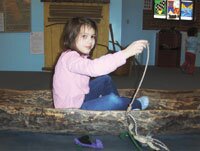CULTURE- BUZZBOX- Beyond Jamestown: Seeing Virginia history differently

Francesca, age 8, catches dinner from a dugout canoe.
The Commonwealth of Virginia, as the story goes, began when Captains Christopher Newport and John Smith established Jamestown as the first permanent English settlement in the New World on May 13, 1607. But stories can be told in many different ways, depending on the perspective of the teller. And while the Jamestown story is the way early European settlers saw the start of our state, others who were present at that moment in history have a very different view.
The current Back Gallery exhibit at the Virginia Discovery Museum invites children of all ages to take a different look at our home, to see it through the eyes of those who watched from the shores as the English ships landed. The exhibit "Beyond Jamestown" examines Virginia history and culture from the perspective of the Chickahominy, Mattaponi, Monacan, and other native people of this area now called Virginia. Originally produced for the Virginia Museum of Natural History and curated by Virginia Indian anthropologist Karenne Wood, a member of the Monacan tribe still thriving in Amherst County, the exhibit is an authentic representation of Virginia's native people.
Visitors to the Back Gallery enter the native world surrounded by the sounds of calling birds, rushing waters, rustling leaves, and the music of a fine wooden flute. In the replica of a longhouse, kids can lounge on a pair of low log benches with a deer hide rug under foot to view a short video in which chiefs from the eight officially recognized Virginia tribes talk of their people's lives– past and present.
An authentic dugout canoe carved from a cypress log invites wee ones to paddle down the river as the Indians once did fishing for striped bass and shad. When they return to shore, kids can cook the catch over the (thankfully not authentic) log fire. Along with the fish, the evening meal may include corn, beans, and squash, the Indians' "three sisters," grown together in the mounded garden nearby.
Displays of Indian crafts show a variety of beaded jewelry, baskets woven from honeysuckle vines, carved wooden flutes, and a sack made of a muskrat hide. Visitors can get in on the craftiness themselves by stitching up a leather pouch or helping to weave a straw mat like those used to build the long house. And little potters can see the steps used in making a clay coil pot– a process they can try at home.
What visitors won't see are costumes of fringed deerskin and plumed headdresses. "We don't want to perpetuate those stereotypes," explains gallery manager Allyson Johns. Indeed, images of modern Virginia Indians displayed around the gallery show them dressed in t-shirts and jeans, suits and ties, just like any 21st century American.
It's a thought-provoking view of American history, not only from the pre-European era, but into modern times. Even those older than the VDM's typical one- to eight-year-old visitor stand to gain a new appreciation for these ancient cultures still flourishing in our midst today.
Beyond Jamestown can be seen at the Virginia Discovery Museum now through May 11. East end of the Downtown Mall. 977-1025.
#